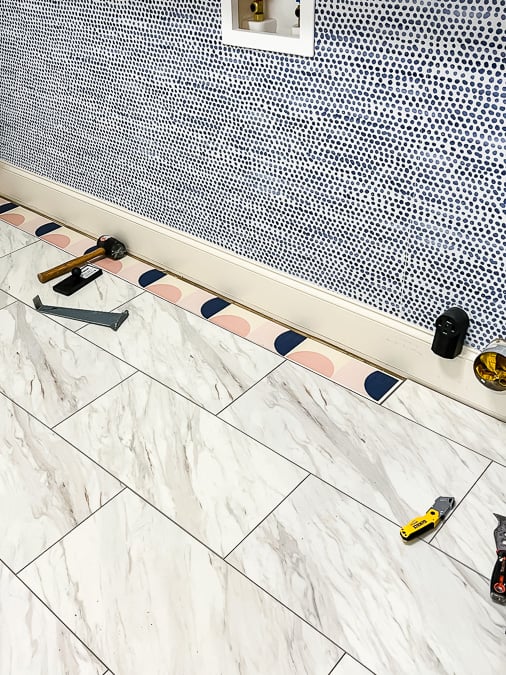Discover the Tricks to Perfect Ceramic Tile Installment Whenever
Accomplishing perfect tile installation may seem like an overwhelming job, commonly leading to irritation and blemishes that diminish the overall aesthetic. However, grasping the art of ceramic tile installation entails a series of specific actions and techniques that, when executed correctly, can result in a refined and smooth surface. From surface area preparation to grout application, each phase plays a vital role in the last outcome of your task. By understanding the tricks behind each step, you can make sure that your ceramic tile installment not just fulfills yet exceeds your expectations.
Appropriate Surface Area Prep Work
Effective ceramic tile setup hinges considerably on meticulous surface preparation to guarantee a perfect result. The surface has to be clean, dry, and structurally appear to protect against future issues such as loose ceramic tiles or split grout.
To assure correct bond, it is suggested to rough up smooth surface areas through sanding or scarifying. Additionally, using a primer can boost bonding between the substratum and the ceramic tile adhesive. Uneven surfaces need to be leveled using a self-leveling substance to avoid lippage and make certain a smooth coating.
Moreover, looking for prospective resources of moisture is essential, as excess moisture can bring about mold and mildew growth and damage the tiles with time. Making use of a dampness obstacle or waterproofing membrane in wet areas like washrooms or kitchen areas is vital to shield the floor tiles from water damages. By thoroughly preparing the surface area prior to floor tile installment, one can develop a visually appealing and durable tiled location that will stand the test of time.

Selecting the Right Adhesive
Selecting the suitable adhesive is a vital action in guaranteeing the successful installation of tiles. The kind of glue you pick will certainly depend upon various variables such as the sort of tile, the substratum material, and the location of the installation. There are various sorts of adhesives offered in the market, including thin-set mortar, mastic, and epoxy.

Epoxy adhesives are water-resistant and very long lasting, making them ideal for locations vulnerable to moisture such as bathrooms or kitchens. They are likewise suitable for mounting glass or metal tiles. When choosing an adhesive, make certain to adhere to the producer's suggestions and consider the particular needs of your tile installation project.
Accuracy Cutting Methods
One of the most typical devices utilized for precision cutting in floor tile setup is the floor tile cutter. Ceramic tile cutters come in different types, consisting of hands-on tile cutters, electrical wet saws, and handheld ceramic tile cutters. Manual floor tile cutters are suitable for straight cuts on ceramic and porcelain tiles, giving clean and precise sides.
Additionally, making use of tools like ceramic tile scribes or glass cutters can aid in Extra resources racking up and breaking ceramic tiles with precision. By mastering these precision reducing strategies, floor tile installers can make sure an expert coating and a visually enticing outcome in their tile projects.

Cement Application Tips
When transitioning from precision cutting methods to grout application in ceramic tile setup, focus to information and technique is extremely important for attaining a perfect surface. Grout offers not just as a functional aspect that loads the voids navigate to this site in between ceramic tiles yet likewise plays a considerable duty in the general visual of the installment.
Once the cement is used, use a damp sponge to clean up the floor tiles, making certain not to eliminate grout from the joints. Complying with these grout application tips will result in a professionally installed tile surface that improves the beauty of any area.
Finishing Touches and Maintenance
To finish the ceramic tile installment project successfully, focus to detail during the ending up touches and regular maintenance is essential. After the cement has dried and the floor tiles are securely in area, the final actions entail making certain that all sides are properly secured. Using a premium sealant around the Find Out More boundary of the tiled location assists stop water damage and extends the life of the installation. Furthermore, looking for any kind of loose ceramic tiles or cement and addressing them immediately can protect against a lot more significant concerns down the line.
Routine maintenance is key to maintaining the beauty and performance of your tiled surface areas. A simple regimen of sweeping or vacuuming complied with by wiping with a mild cleaner can assist maintain your tiles looking beautiful (tile installation austin). For locations that are frequently revealed to wetness, such as bathrooms or kitchens, normal resealing of cement lines is suggested to stop mold and mildew and mildew development
Final Thought
To conclude, achieving excellent tile setup every single time calls for attention to detail and correct techniques. By concentrating on surface area preparation, choosing the proper adhesive, using accuracy reducing approaches, using cement thoroughly, and completed with interest to information, you can make certain a professional-looking result. Remember to comply with these steps and preserve your ceramic tiles consistently to prolong their lifespan and keep them looking their ideal.
One of the most usual tools made use of for precision cutting in tile setup is the tile cutter. Floor tile cutters come in different types, consisting of hand-operated ceramic tile cutters, electrical wet saws, and handheld floor tile cutters. Manual tile cutters are appropriate for straight cuts on ceramic and porcelain ceramic tiles, providing clean and accurate sides. Furthermore, utilizing tools like floor tile scribes or glass cutters can assist in scoring and breaking floor tiles with accuracy. By mastering these precision reducing techniques, ceramic tile installers can ensure a professional surface and an aesthetically enticing result in their tile tasks.